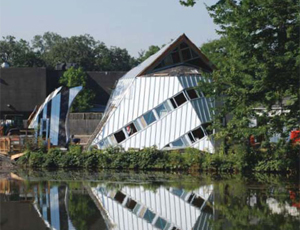New starts are off, but many owners ready to move forward are still seeking greener structures.
“Sustainable design is more important than ever, and the recession validates it is not about initial costs; it’s about operating cost,” says Rick Bell, executive director of AIA New York.

Bill Amann, board chairman of U.S. Green Building Council New Jersey, president of M&E Engineers in Somerville, N.J., and chairman of the Somerset County Energy Council, says there is greater demand for both green design and reducing the carbon footprint, even once energy costs began to fall.
“We don’t see people backing off, because the energy prices came back down,” Amann says. “If anything they are more interested, knowing that what goes down must come back up. And they want to be prepared for that.”
Pat Sapinsley, a senior associate with Good Energies, a New York venture capital firm and co-chair of the AIA New York’s Committee on the Environment, says she finds owners more interested in sustainable design. And her research indicates that manufacturers are focusing on green products to distinguish themselves from the competition.
“It is as easy to do it green as not green,” Sapinsley says. “There’s an upturn in green construction where there is a downturn in other construction.”
Peter Syrett, associate principal at Perkins+Will – which recently designed the LEED Gold $13.5 million Training and Education Center for Semiconductor Manufacturing and Alternative and Renewable Technologies for Hudson Valley Community College in Malta, N.Y. – says the industry has reached the tipping point.
“There’s been a fundamental shift in thinking,” Syrett says. “This is not an additive thing but a core requirement of how we approach the built environment.”
“I don’t think the recession has had a significant impact on sustainability,” adds Charles Griffith, associate partner of Polshek Partnership Architects and co-chair of the AIA New York’s Committee on the Environment. “The real driver is building ownership.”
Griffith adds that many long-term owners, recognizing the benefits of sustainable design, demand green features.
“It’s not in their long-term profitability picture not to [go green],” Griffith says. “Even though the economy might be down, I don’t see that as changing.”
Randy Croxton, president and founder of Croxton Collaborative Architects in New York, also indicates the recession has not dampened owners’ enthusiasm for sustainability.
“It’s fundamentally a change in the marketplace, it’s a change in expectations and it’s establishing a new threshold of quality,” Croxton says. “The beauty of how LEED has evolved and the standards continue to evolve over time has redefined quality thresholds and what is possible within practice.”
Improvements in productivity and decreasing costs for green products have made building green as economical as any other project.
“The single greatest illusion is that it costs significantly more,” Croxton says. “The concepts of green or sustainable design can be accomplished at or below the benchmark price for building type. There is no green premium.”
Croxton recently designed the Beacon (N.Y.) Institute for Rivers and Estuaries’ Center for Advanced Environmental Technology, which the firm anticipates will achieve LEED-Platinum certification.
New York State ranks seventh in the United States in the number of LEED certified building with 146, but has the second-highest number of LEED-registered projects at 1,596. New Jersey has 60 LEED-certified and...

Post a comment to this article
Report Abusive Comment